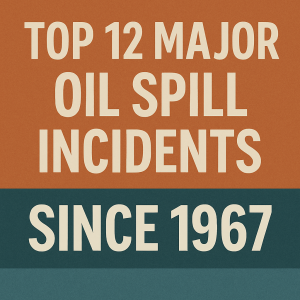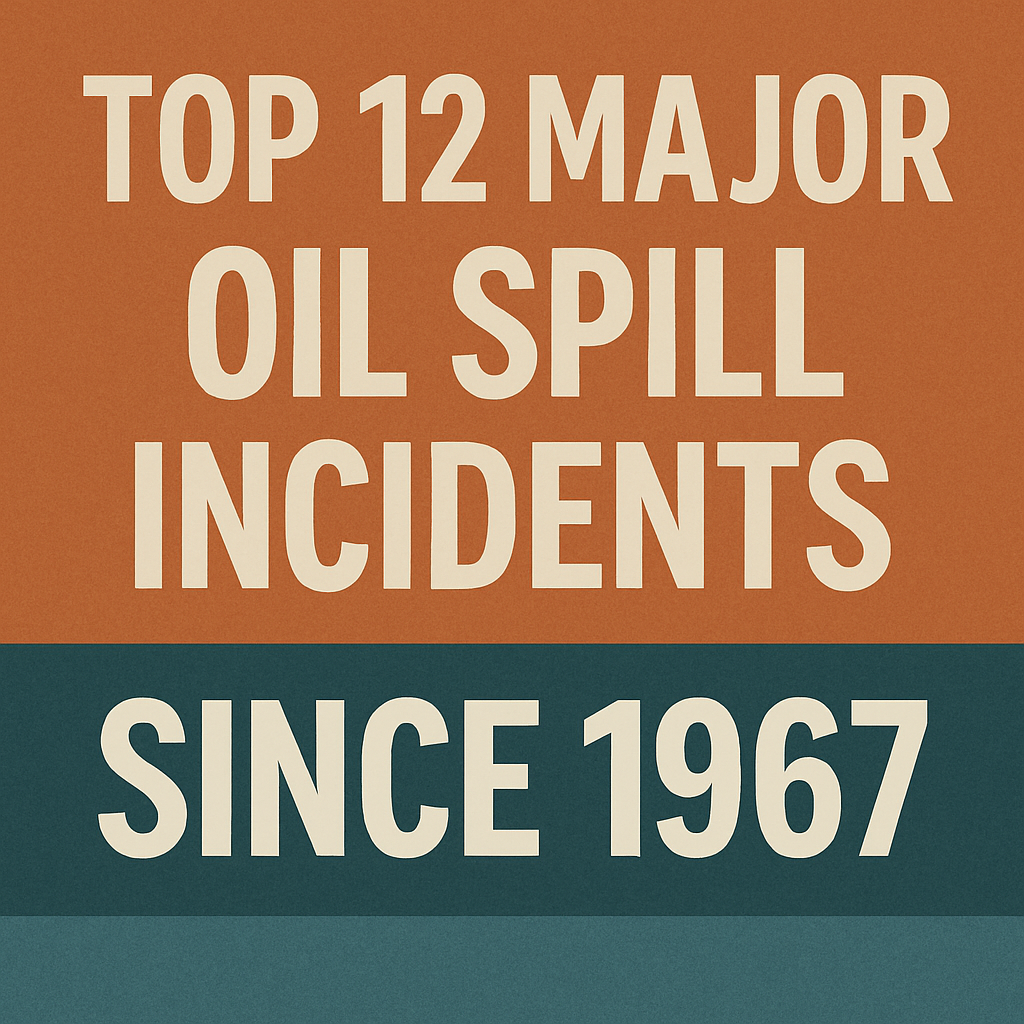Discover the top 12 major oil spill incidents since 1967 that reshaped maritime safety, environmental policies, and global shipping. Learn from real-world disasters that drove reforms and innovation in the maritime industry.
Why Oil Spill Disasters Matter in Maritime Operations
Oil spills are among the most devastating consequences of maritime accidents. Unlike many other forms of pollution, spilled crude or refined oil spreads quickly, suffocating marine ecosystems, threatening coastal economies, and prompting global regulatory responses. From tankers running aground to offshore rig failures, each incident leaves a trail of environmental and political consequences.
These events not only reshape coastlines but also influence international conventions—such as MARPOL and the OPRC Convention—and inspire changes in ship design, emergency response systems, and operator accountability. As the International Maritime Organization (IMO) notes, the oil pollution record of the industry has improved dramatically over the decades, but legacy incidents still guide modern reforms.
Let’s revisit the top 12 oil spills since 1967, not to sensationalise disaster, but to understand the risks, lessons, and progress they provoked.

In-Depth Analysis: The 12 Most Catastrophic Oil Spills Since 1967
1. Torrey Canyon (1967) – United Kingdom
Volume: ~119,000 tonnes of crude oil
Location: Scilly Isles, UK
This was the first major oil tanker disaster of the modern era. The Liberian-flagged Torrey Canyon struck a reef off Cornwall and released thousands of tonnes of oil, devastating English and French coastlines.
Legacy: It led directly to the formation of the International Convention on Civil Liability for Oil Pollution Damage (CLC 1969).
Reference: IMO – CLC 1969 Overview
2. Amoco Cadiz (1978) – France
Volume: ~223,000 tonnes of crude oil
Location: Coast of Brittany, France
After suffering a steering failure, the VLCC Amoco Cadiz grounded, spilling its entire cargo. The event contaminated over 300 km of French coastline.
Impact: Triggered a major shift in French and EU maritime policies and bolstered the EU’s role in maritime pollution response.
Related Policy: Paris MoU on Port State Control was strengthened as a result.
3. Ixtoc I (1979) – Gulf of Mexico
Volume: Estimated 454,000–1,500,000 tonnes
Type: Offshore oil rig blowout
Owned by Pemex, this incident involved a well blowout that lasted nine months. It’s one of the largest oil spills in history and served as a grim precursor to later offshore disasters.
Scientific Insight: Prompted offshore engineering standards updates globally, and reinforced calls for better BOP (Blowout Preventer) systems.
4. Atlantic Empress (1979) – Caribbean Sea
Volume: ~287,000 tonnes
Two VLCCs—Atlantic Empress and Aegean Captain—collided off Trinidad and Tobago, resulting in massive fire and oil discharge. The Empress later sank, continuing to leak oil.
Takeaway: Collision and explosion risk with large tankers prompted improvements in navigation systems and bridge team training (see STCW Code updates).
5. ABT Summer (1991) – Atlantic Ocean
Volume: ~260,000 tonnes
Location: ~1,300 km off Angola
An explosion on board followed by fire caused the vessel to sink. The remote location delayed mitigation efforts, allowing a significant amount of oil to enter the open sea.
Lesson Learned: The case highlighted the need for faster satellite-based oil spill monitoring (e.g., Inmarsat integration).
6. Castillo de Bellver (1983) – South Africa
Volume: ~252,000 tonnes
This Spanish tanker caught fire and broke in two near Cape Town. The bow sank with oil cargo, but thanks to favourable winds, most oil dispersed offshore.
Environmental Win: Demonstrated how wind and sea conditions can mitigate or worsen impacts.
7. Nowruz Field (1983) – Persian Gulf
Volume: ~260,000 tonnes
Cause: War-related damage during the Iran-Iraq conflict
A collision between a tanker and offshore platform led to oil leakage and fire. Repairs were delayed due to military conflict.
Wider Impact: A stark example of how geopolitical instability escalates environmental risk.
8. Exxon Valdez (1989) – United States (Alaska)
Volume: ~37,000 tonnes
Though smaller in volume, the impact was severe due to the ecological sensitivity of Prince William Sound. The Exxon Valdez grounding shocked the U.S. public and policymakers.
Reforms Introduced: The U.S. passed the Oil Pollution Act of 1990 (OPA 90), mandating double hulls on tankers.
Reference: NOAA – Exxon Valdez Spill
9. Haven (1991) – Mediterranean Sea
Volume: ~145,000 tonnes
This VLCC exploded and sank off the coast of Genoa, Italy. Oil burned and leaked for days, contaminating beaches.
Outcome: Renewed focus on fire safety regulations and better cargo tank monitoring.
Class Response: ABS and RINA reviewed their fire classification notations after this event.
10. Prestige (2002) – Spain
Volume: ~63,000 tonnes
The aging single-hull tanker broke apart in a storm off Galicia, releasing heavy fuel oil. Spain and the EU faced political fallout for denying the ship a safe port.
Policy Impact: Accelerated the EU ban on single-hull tankers.
Reference: European Maritime Safety Agency (EMSA) – Prestige Incident Summary
11. Hebei Spirit (2007) – South Korea
Volume: ~10,500 tonnes
A crane barge collided with this anchored VLCC, causing major coastal damage. The cleanup was long and complex.
Legal Aftershock: The master and chief officer were initially jailed, raising international outcry about the fair treatment of seafarers.
Supported By: ITF and IMO legal advocacy campaigns.
12. Deepwater Horizon (2010) – United States (Gulf of Mexico)
Volume: Estimated 4.9 million barrels (~780,000 tonnes)
This offshore rig explosion became the worst accidental marine oil spill in history. Eleven workers died, and BP faced billions in penalties.
Key Consequence: The U.S. government imposed stricter offshore drilling oversight, and IACS members reviewed classification protocols for MODUs (Mobile Offshore Drilling Units).
Reference: U.S. Coast Guard Report – Deepwater Horizon
Lessons from These Incidents
Across these events, a few core patterns emerge:
- Double-hull mandates (e.g., under MARPOL Annex I) were adopted after incidents like Exxon Valdez and Prestige.
- Ballast water discharge rules tightened following extensive cleanup efforts.
- International conventions—OPRC, MARPOL, and CLC—were significantly shaped by these disasters.
- Satellite technology, ECDIS, and environmental sensors are now standard aboard tankers.
Even today, the shadow of these spills influences training modules under the STCW Convention and port state control operations.
FAQ
Which was the biggest oil spill in volume?
The Deepwater Horizon disaster is the largest accidental spill in marine history in terms of volume.
Are offshore rigs safer now?
Yes. Post-2010, BOP systems are more advanced, and IACS classification has improved for offshore structures.
Why is the Exxon Valdez still so famous?
Its ecological impact and the resulting legislation (OPA 90) make it a key case in maritime history.
Are single-hull tankers still in use?
No, most were phased out under MARPOL amendments. Double-hull construction is now the global standard.
How are spills monitored today?
Using satellites, drones, and real-time sensors (e.g., Inmarsat and MarineTraffic tools).
Do IMO conventions change after major spills?
Yes. The IMO often uses high-profile disasters to shape policy, training, and inspection regimes.
Conclusion
Oil spills are among the most visible and long-lasting maritime disasters, but they’ve also pushed the industry to evolve. From regulatory frameworks like MARPOL and OPA 90 to technological innovations in hull design and emergency response, each spill leaves a legacy.
For maritime professionals, these events are not just historical footnotes—they’re practical case studies. They shape how ships are built, how crews are trained, and how ports prepare for the worst.
Whether you’re an engineer, a policymaker, or a student, understanding these incidents helps us prevent future tragedies and protect our oceans for generations to come.
References
- International Maritime Organization (IMO). www.imo.org
- U.S. Coast Guard. https://www.uscg.mil
- European Maritime Safety Agency (EMSA). www.emsa.europa.eu
- NOAA Office of Response and Restoration. https://response.restoration.noaa.gov
- ITF Seafarers. www.itfseafarers.org
- IACS Reports. www.iacs.org.uk
- U.S. Environmental Protection Agency. https://www.epa.gov
- MarineTraffic. www.marinetraffic.com
- MARPOL Convention. https://www.imo.org/en/About/Conventions/Pages/International-Convention-for-the-Prevention-of-Pollution-from-Ships-(MARPOL).aspx
- UNCTAD Review of Maritime Transport. https://unctad.org/topic/transport-and-trade-logistics/review-of-maritime-transport

